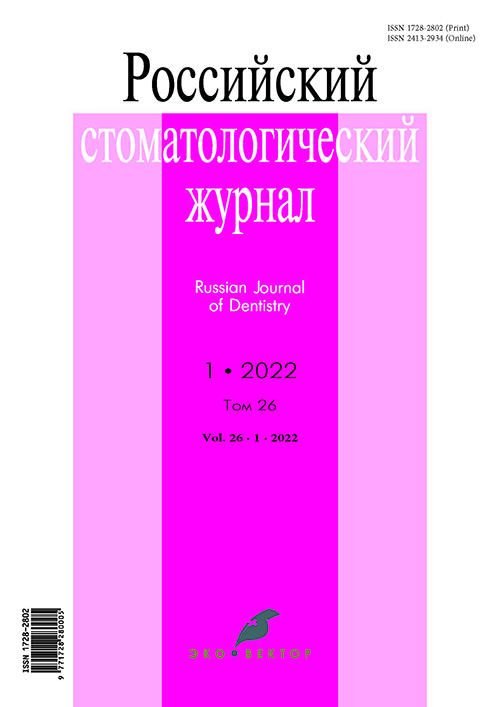Necessary orthodontic treatment assessment of orphans
- 作者: Akhmedova S.K.1, Slabkovskaya A.B.1, Magomedov R.R.1, Morozova N.V.1, Terekhina N.V.2, Drobysheva L.A.1
-
隶属关系:
- A.I. Evdokimov Moscow State University of Medicine and Dentistry
- Family Unit Center at the Marfo-Mariinsky Monastery of Mercy
- 期: 卷 26, 编号 1 (2022)
- 页面: 49-56
- 栏目: Clinical Investigation
- ##submission.dateSubmitted##: 31.08.2022
- ##submission.dateAccepted##: 31.08.2022
- ##submission.datePublished##: 31.08.2022
- URL: https://rjdentistry.com/1728-2802/article/view/110724
- DOI: https://doi.org/10.17816/1728-2802-2022-26-1-49-56
- ID: 110724
如何引用文章
详细
BACKGROUND: The orthodontic treatment leads not only to functional normalization of the stomatognathic system but also to smile aesthetic changes, which helps to increase a person’s self-esteem. Moreover, the level of neuropsychicological development revealed that approximately 6% of orphans are included in the group of healthy people following the coefficient of mental development, and 94% of pupils of the orphanage with sensory, motor, emotional, behavioral, and cognitive sphere retardation are in the risk and pathology group.
AIM: This study aimed to assess the psychological status of children without parental care, based on the “Picture of a Person” test.
MATERIAL AND METHODS: This study included 44 children from the orphanage aged 7–17 years to assess their psychological status using the “Picture of a Person” test.
RESULTS: Difficult life circumstances lead to developmental peculiarities in children. However, the desire for social communication remains, the aesthetics of appearance are valued, and the desire to impress increases. This indicates the need to work not only on the psychological state of children without parental care but also to educate them on the right attitude toward health and beauty, to create opportunities for self-improvement with the help of various specialists (dentists, orthodontists, dermatologists, etc.), which will help increase self-esteem.
CONCLUSION: The study demonstrates the need for children without parental care in social communication. Great importance is attached to the aesthetics of the face and teeth. Dentists can contribute to the successful adaptation of orphaned children in society, paying attention to the treatment not only to the health of the dental system but also to the beauty of a smile. Orthodontic treatment can help in educating orphans with the qualities necessary for their socialization.
全文:
作者简介
Siyasat Akhmedova
A.I. Evdokimov Moscow State University of Medicine and Dentistry
编辑信件的主要联系方式.
Email: siyasat.akhmedova@gmail.com
俄罗斯联邦, Moscow
Anna Slabkovskaya
A.I. Evdokimov Moscow State University of Medicine and Dentistry
Email: slabkovskaya.ann@mail.ru
MD, Dr. Sci. (Med.), Professor
俄罗斯联邦, MoscowRadzhab Magomedov
A.I. Evdokimov Moscow State University of Medicine and Dentistry
Email: dr.radzhab.magomedov@gmail.com
俄罗斯联邦, Moscow
Natalya Morozova
A.I. Evdokimov Moscow State University of Medicine and Dentistry
Email: nmorozka72@mail.ru
MD, Cand. Sci. (Med.)
俄罗斯联邦, MoscowNadezhda Terekhina
Family Unit Center at the Marfo-Mariinsky Monastery of Mercy
Email: n.tere73@yandex.ru
俄罗斯联邦, Moscow
Liya Drobysheva
A.I. Evdokimov Moscow State University of Medicine and Dentistry
Email: liyaliya989898@gmail.com
俄罗斯联邦, Moscow
参考
- Doskin VA, Tonkova-Yampol’skaya RV. Novyi metod reabilitatsii detei s razlichnymi narusheniyami povedeniya. Voprosy sovremennoi pediatrii. 2003;2(2):84–85. (In Russ).
- Konova SR. Sostoyanie zdorov’ya detei i sovershenstvovanie meditsinskoi pomoshchi v usloviyakh pervichnogo zvena zdravookhraneniya [dissertation]. Moscow; 2007. (In Russ).
- Al’bitskii VY, Baranov AA, Kamaev IA, Rezaikin VI. Chasto boleyushchie deti aktual’naya problema sotsial’noi pediatrii. In: Sotsial’nye i organizatsionnye problemy pediatrii. Moscow: Dinastiya, 2003. P:233–252. (In Russ).
- Berezovskii IV. Sotsial’no-gigienicheskaya kharakteristika detei, vospityvayushchikhsya v detskikh domakh. Zdravookhranenie Rossiiskoi Federatsii. 1994;(2):23–25. (In Russ).
- Leshchenko MV, Tonkova-Yampol’skaya RV, Frukht EL. Sostoyanie zdorov’ya i razvitiya vospitannikov domov rebenka. Russian pediatric journal. 2000;(1):48–49. (In Russ).
- Mukhamedrakhimov RZh. Mat’ i mladenets: psikhologicheskoe vzaimodeistvie. Saint Petersburg, 2003. 286 p. (In Russ).
- Bondar’ VI. Osnovnye tendentsii meditsinskoi reabilitatsii v domakh rebenka. Meditsinskaya pomoshch’. 1996;(5):18–20. (In Russ).
- Doskin VA, Makarova ZS, editors. Razvitie i vospitanie detei v domakh rebenka. Moscow: Vlados-Press, 2007. 375 p. (In Russ).
- Pavlikov AV. Somaticheskii i nervno-psikhicheskii status detei-vospitannikov Doma rebenka [dissertation]. Moscow; 2010. (In Russ).
- Venger AL. Psikhologicheskie risunochnye testy: Illyustrirovannoe rukovodstvo. Moscow: Vlados-Press, 2003. (In Russ).
补充文件
















